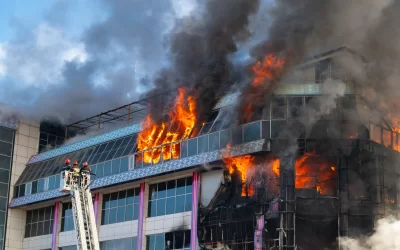Fire Regulations: Why Fire Safety is Critical for UK Businesses

In the realm of business operations within the UK, the adherence to fire regulations emerges not merely as a legal necessity but as a pivotal foundation of safety and responsibility. The imperative of safeguarding lives, assets, and property against the devastating potential of fire underscores the elemental role of fire safety within the organizational structure. This directive necessitates a comprehensive understanding of fire regulations, ensuring that establishments are not only compliant but are also fostering a secure environment for employees, customers, and the wider community.
The exploration of fire regulations in the UK, detailed in this article, provides a framework structured around the vital aspects of fire safety, including fire risk assessment, the designation of a responsible person, and the formulation of effective evacuation procedures. Emphasizing why fire safety is essential for businesses, the discussion navigates through the steps to ensure fire safety in your business, offering a roadmap towards compliance and security. This guidance is crucial in equipping businesses with the knowledge and strategies to mitigate fire risks, safeguarding their workforce and operations against unforeseen disasters.
Understanding Fire Regulations in the UK
Key Legislation and Guidelines
The Regulatory Reform (Fire Safety) Order 2005 and the Fire Safety (England) Regulations 2022 establish a comprehensive framework for fire safety in the UK. These regulations place significant responsibility on designated individuals, known as the Responsible Person, to ensure compliance and safety of all occupants within their premises1]. Additionally, the Fire Safety Act and the Building Safety Act have introduced stringent measures to manage fire risks effectively, particularly in multi-occupied residential buildings.
Differences Across Regions
Fire safety regulations vary across the UK, with distinct guidelines for England, Wales, Scotland, and Northern Ireland. For instance, England, Wales, and Scotland have banned combustible cladding for residential buildings over 18 meters tall, while Northern Ireland has not yet introduced such a ban. Sprinkler requirements also differ, with mandatory installation in residential buildings of varying heights across the regions.
Penalties for Non-Compliance
Failure to comply with fire safety regulations can result in severe penalties, including fines and imprisonment. The penalties are designed to enforce compliance and can be particularly harsh, with fines increasing significantly post-Grenfell. For example, the average fine post-Grenfell is £27,519, which is 35% higher than the average between 2014 and 2019. Enforcement notices and prohibition notices are tools used by authorities to ensure that necessary safety measures are implemented.
Why Fire Safety is Essential for Businesses
Protecting Lives
Fire safety measures are critical in safeguarding the lives of employees and customers. By conducting regular fire risk assessments and implementing fire safety inspections, businesses can identify potential hazards and take corrective actions to prevent fires from starting or spreading. This proactive approach helps in reducing the risk of injuries or fatalities, ensuring a safer environment for all individuals within the premises.
Reducing Property Damage
Fires can cause extensive property damage, leading to significant financial losses for businesses. Regular fire safety inspections and adherence to fire regulations help in mitigating these risks by identifying and addressing potential fire hazards 6]. Moreover, by investing in reliable fire detection systems and maintaining them properly, businesses can minimize the damage caused by fires, preserving their assets and operations.
Avoiding Legal Liabilities
Compliance with fire safety regulations is not only a legal requirement but also a crucial step in avoiding severe penalties and legal liabilities. Failure to comply can result in fines, penalties, or even the closure of the business. By prioritizing fire safety and ensuring that all safety measures are in place, businesses can avoid legal repercussions and maintain their reputation as responsible entities committed to the safety of their stakeholders.
Steps to Ensure Fire Safety in Your Business
Conducting Fire Risk Assessments
To ensure fire safety, businesses must start by conducting thorough fire risk assessments. This involves identifying potential fire hazards and the people at risk, evaluating and mitigating those risks, and recording the findings. It is crucial for businesses to not only carry out these assessments but also review and update them regularly to adapt to any changes in the environment or operations. For larger or more complex setups, it may be necessary to engage a qualified specialist to ensure thoroughness and compliance.
Implementing Safety Measures
Once risks are assessed, implementing appropriate safety measures is the next critical step. This includes installing and maintaining fire detection and warning systems, ensuring proper storage of combustible materials, and equipping the premises with adequate firefighting equipment. Regular maintenance checks of these systems are mandated to ensure they function when needed most. It is also essential to comply with legal requirements for emergency routes and exits, and for the equipment to be accessible and in good working condition.
Ongoing Training and Maintenance
Ongoing training for all employees is paramount in maintaining a safe working environment. This training should cover fire prevention techniques, the use of firefighting equipment, and emergency evacuation procedures. Regular drills should be conducted to ensure everyone knows their role in an emergency, thereby reducing the risk of panic and confusion. Additionally, maintaining all safety equipment and systems according to the legal standards is not just a regulatory requirement but a critical practice to ensure they operate effectively during emergencies Regular testing and servicing of fire alarms and extinguishers should be conducted by competent persons to maintain functionality and compliance.
Conclusion
Throughout this discussion, we’ve taken an in-depth look at the paramount importance of fire safety within UK businesses, underscoring not only the legal obligations pertaining to fire regulations but also the ethical and operational imperative to safeguard lives, assets, and the integrity of businesses. The foundational elements of conducting fire risk assessments, identifying a responsible person, and creating and maintaining effective evacuation procedures all contribute to forming an environment that prioritizes safety and mitigates the risk of fire. Emphasizing compliance, we’ve seen how adhering to regulations can protect businesses from severe penalties, loss of property, and, most critically, loss of life.
As businesses move forward, it’s vital to remember that fire safety is an ongoing process, demanding constant attention, regular updates to risk assessments, and a commitment to training and equipping employees adequately. To navigate the complexities of fire regulations and ensure comprehensive compliance, seeking professional guidance is a proactive step towards achieving peace of mind and operational security. Calling or emailing RMT Solutions today is a seamless way to ensure that your business remains compliant and protected against the ever-present risk of fire. In strengthening your fire safety measures, you contribute to a safer community and a more resilient business landscape.
FAQs
- Why is adhering to fire safety regulations crucial?
Adhering to fire safety regulations is crucial because it ensures that adequate and appropriate measures are in place to reduce the risk of injury or death in the event of a fire. - What does the UK Fire Safety Act entail?
The Fire Safety Act in the UK specifies that responsible persons for multi-occupied residential buildings must manage and reduce fire risks. This includes overseeing the safety of the building’s structure, external walls, cladding, balconies, windows, and entrance doors to individual flats that open into communal areas. - What fire safety requirements must UK commercial buildings meet?
UK commercial buildings must be equipped with fire extinguishers, safety signs, emergency lighting, fire alarms, and fire doors to comply with fire safety regulations. - What is the British standard for managing fire safety?
The British standard BS 9991 provides guidelines for the ongoing management of fire safety throughout a building’s lifecycle. It includes advice for designers on how to ensure that a building’s design supports and improves fire safety management.


0 Comments